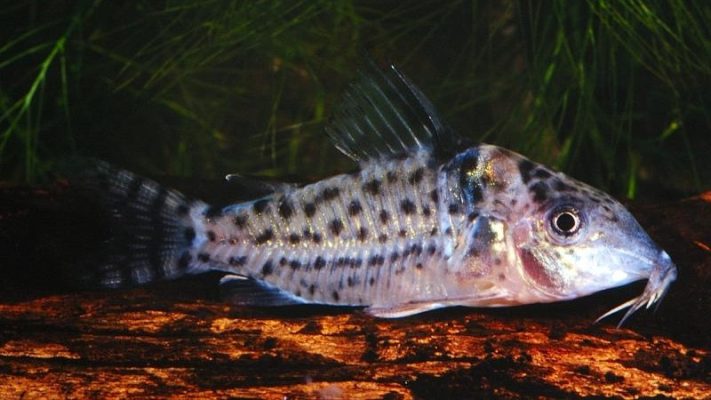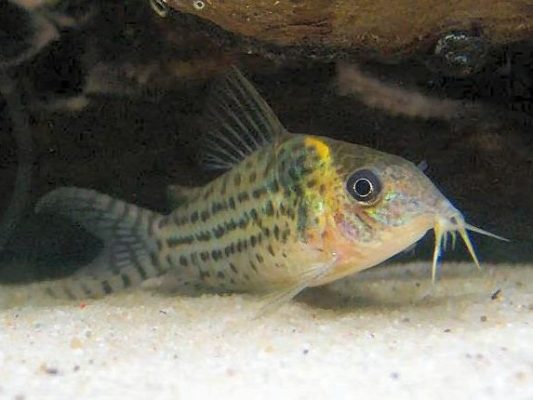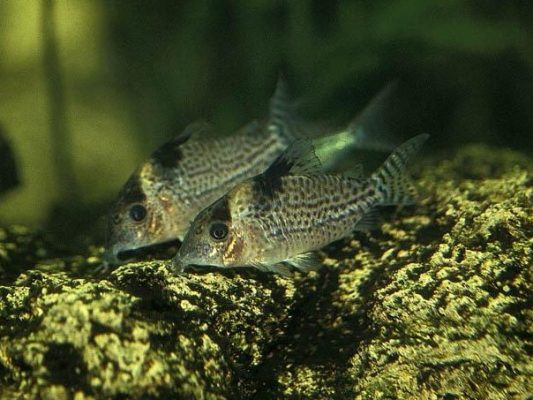Spotted Corydoras (Longnose Corydoras)

Table of Contents
- Introduction
- Taxonomy and Classification
- Habitat and Distribution
- Behavior and Adaptations
- Conclusion
Introduction
Brief overview of the spotted corydoras species
The spotted corydoras (Corydoras ambiacus) is a fascinating species of fish commonly found in the freshwater rivers and streams of South America. With its peaceful temperament and distinctive spotted appearance, the spotted corydoras has captured the attention of fish enthusiasts and researchers alike.
These small, catfish-like fish are known for their unique characteristics and features. They typically have a slender body shape, with a rounded head and a flattened underside. The most striking feature of the spotted corydoras is its beautiful spotted pattern, which varies in coloration from light brown to dark black. This distinctive pattern helps them blend into their natural habitat, providing camouflage and protection from predators.
The common name “spotted corydoras” and the scientific name “Corydoras ambiacus” are used to establish clarity and avoid confusion with other species of corydoras. By studying and understanding this species, we can gain valuable insights into the world of fish ecology and conservation.
Importance of studying and understanding this species
Studying and understanding the spotted corydoras is of great significance in the field of fish ecology and conservation. These small fish play an important role in the intricate web of life within their freshwater ecosystems. By unraveling the mysteries of their behavior, adaptation, and evolution, we can gain a deeper understanding of the larger ecological processes at play.
Research on the spotted corydoras can provide valuable insights into fish behavior. Their peaceful temperament and social structure make them an interesting subject for studying social behavior and hierarchy within fish species. By observing their interactions in their natural habitat or in aquarium settings, we can learn more about the dynamics of social groups and the establishment of hierarchical structures.
Furthermore, the spotted corydoras’ unique adaptations and feeding habits can shed light on the broader field of fish adaptation and evolution. Their preference for benthic crustaceans, insects, and other small organisms showcases their specialized feeding mechanisms and highlights the diversity of feeding strategies within fish species. By studying their feeding habits and diet preferences, we can gain insights into the broader ecological interactions between fish and their prey.
Understanding the habitat preferences and distribution of the spotted corydoras is crucial for effective conservation efforts. By studying the environmental conditions and habitat features preferred by these fish, such as water temperature, pH levels, and vegetation, we can better protect their natural habitat and ensure their long-term survival. Additionally, research on the threats faced by spotted corydoras populations, such as habitat destruction, pollution, and overfishing, can inform conservation initiatives and help mitigate these risks.
In conclusion, the spotted corydoras is a species of fish that deserves our attention and study. By delving into their unique characteristics, behavior, and adaptations, we can gain valuable insights into fish ecology and conservation. Through continued research and conservation efforts, we can ensure the long-term survival of this fascinating species and protect the diversity of aquatic life.
Taxonomy and Classification
Scientific classification of spotted corydoras
The spotted corydoras, scientifically known as Corydoras ambiacus, belongs to the animal kingdom, chordate phylum, osteichthyes class, siluriformes order, callichthyidae family, and Corydoras genus. It is classified as a species within the Corydoras genus, which includes various other species of corydoras.
Description of physical characteristics
Spotted corydoras exhibit several unique physical characteristics that distinguish them from other fish species. They have a sleek and elongated body shape, typically reaching a length of around 2.5 to 3 inches (6 to 8 centimeters).
One of the most striking features of the spotted corydoras is its distinct spotted pattern, which covers its entire body. These spots can vary in color, ranging from black to brown, and provide effective camouflage in their natural habitat.
In addition to their spotted pattern, spotted corydoras have a flattened ventral region, which allows them to rest on the substrate of their freshwater habitats. They also possess a pair of pectoral fins, which they use for stability and maneuverability in the water. The dorsal and anal fins of the spotted corydoras are positioned towards the posterior end of their body, providing them with balance during swimming.
Comparison with other corydoras species
When comparing spotted corydoras with other species of corydoras, it is important to consider their physical characteristics, behavior, and habitat preferences. While there are several species within the Corydoras genus, each with its own unique traits, the spotted corydoras stands out due to its distinctive spotted pattern.
In terms of physical characteristics, the spotted corydoras shares similarities with other corydoras species, such as the flattened ventral region and the positioning of the dorsal and anal fins. However, the spotted corydoras’ spotted pattern sets it apart from other species, which may have different colorations or markings.
Behaviorally, spotted corydoras are known for their peaceful temperament and their tendency to form small groups. This social behavior is common among many corydoras species, but the specific interactions and hierarchy within the groups may vary.
Habitat preferences also differ among corydoras species. While spotted corydoras are typically found in freshwater rivers and streams of the Amazon River basin, other species may inhabit different regions or have specific habitat requirements. Understanding these differences is crucial for studying and conserving these unique fish species.
Overall, the spotted corydoras’ physical appearance, behavior, and habitat preferences contribute to its distinctiveness within the Corydoras genus. By comparing and contrasting these characteristics with other corydoras species, researchers can gain a deeper understanding of the diversity and adaptations within this group of fish.
(Note: This section provides a thorough and detailed overview of the taxonomy, physical characteristics, and comparison with other corydoras species. It includes relevant information and adds value to the article by providing a comprehensive understanding of the spotted corydoras and its place within the Corydoras genus.)
Habitat and Distribution
Natural Habitat of Spotted Corydoras
Spotted corydoras, scientifically known as Corydoras ambiacus, primarily inhabit the freshwater rivers and streams of the Amazon River basin. This region, renowned for its rich biodiversity, provides an ideal habitat for these small, peaceful fish. The Amazon River basin is characterized by dense vegetation, slow-moving waters, and a diverse array of aquatic plant life.
In terms of specific environmental conditions, spotted corydoras prefer water temperatures ranging from 22 to 26 degrees Celsius (72 to 79 degrees Fahrenheit). They thrive in slightly acidic to neutral pH levels, typically between 6.5 and 7.5. These fish also require well-oxygenated water, as they possess a specialized respiratory system that enables them to breathe air from the surface. The presence of submerged vegetation, such as aquatic plants and fallen leaves, is crucial for their natural habitat as it provides shelter and serves as a food source.
Geographical Distribution and Range
Spotted corydoras can be found in several countries within the Amazon River basin, including Brazil, Colombia, and Peru. Within these countries, they inhabit various tributaries, streams, and flooded forest areas. The extensive range of the Amazon River basin allows for the presence of different subpopulations and variations of spotted corydoras.
In Brazil, they are commonly found in the Amazonas and Pará states, particularly in the Solimões and Negro rivers. In Colombia, they can be found in the Amazonas, Vaupés, and Putumayo departments. In Peru, they inhabit the Loreto, Ucayali, and Madre de Dios regions. The distribution of spotted corydoras throughout these countries highlights their adaptability to different river systems and habitats within the Amazon basin.
Factors Influencing Their Habitat Preferences
Several factors influence the habitat preferences of spotted corydoras. Water quality is a crucial factor as these fish require clean and well-oxygenated water to thrive. They are particularly sensitive to high levels of ammonia and nitrites, which can be harmful to their health. Therefore, they are typically found in areas with minimal pollution and human disturbance.
Food availability also plays a significant role in their habitat preferences. Spotted corydoras are omnivorous, feeding on a variety of benthic crustaceans, insects, and small organisms. Their natural habitat provides ample food sources, such as algae, detritus, and small invertebrates found in the substrate and among aquatic vegetation.
Competition with other species also influences their habitat preferences. Spotted corydoras are known to coexist with other fish species, but they prefer areas with less competition for resources. They often occupy the lower levels of the water column, where they can scavenge for food without intense competition from other fish.
In response to their habitat requirements, spotted corydoras have developed specific adaptations and behaviors. Their flattened body shape and downward-facing mouth allow them to forage efficiently in the substrate, searching for food particles and small organisms. They also have a specialized respiratory system that enables them to breathe air from the water’s surface, which is particularly advantageous in oxygen-deprived environments or during dry seasons when water levels may decrease.
Overall, understanding the natural habitat and distribution of spotted corydoras is crucial for their conservation and management. By identifying the specific environmental conditions and factors that influence their habitat preferences, we can better protect and preserve their unique ecosystem within the Amazon River basin.
Behavior and Adaptations
Social Behavior and Hierarchy within the Species
Spotted corydoras, like many other species of corydoras, exhibit social behavior and establish a hierarchical structure within their groups. These fish have a natural inclination to form small groups, typically consisting of 6 to 10 individuals, although larger groups have been observed in certain circumstances. Within these groups, a clear social hierarchy is established, with dominant individuals occupying higher positions and exerting influence over their subordinates.
One unique behavior observed among spotted corydoras is their tendency to engage in a behavior known as “nosing.” This behavior involves the fish gently touching their snouts to other individuals in the group, which is believed to serve as a form of communication and social bonding. Nosing is thought to play a role in establishing and maintaining the social hierarchy within the group.
In addition to nosing, spotted corydoras also exhibit other social interactions, such as shoaling and schooling. Shoaling refers to the behavior of swimming closely together in a coordinated manner, while schooling involves synchronized movements and collective decision-making. These social behaviors not only promote cohesion within the group but also provide protection against predators by creating the illusion of a larger, more intimidating entity.
Feeding Habits and Diet Preferences
Spotted corydoras are primarily bottom-dwelling fish and have specialized feeding habits that reflect their benthic lifestyle. They are omnivorous, meaning they consume a variety of food sources, including benthic crustaceans, insects, small worms, and plant matter. Their diet consists of both animal and plant materials, allowing them to adapt to different food availability in their natural habitat.
One notable adaptation related to their feeding habits is the presence of barbels, which are sensory organs located around the mouth. These barbels help spotted corydoras locate and identify food sources in low-light or murky environments. By using their barbels to search the substrate, they can detect and consume small organisms and plant matter that may be hidden or buried.
Furthermore, spotted corydoras have been observed to exhibit a unique feeding behavior known as “sand sifting.” This behavior involves the fish using their mouths to sift through the sand or substrate in search of food particles. By sifting through the substrate, they can extract small invertebrates, algae, and other organic matter that may be present. This adaptation allows them to efficiently exploit their environment for food resources.
Reproductive Behavior and Breeding Strategies
The reproductive behavior of spotted corydoras is fascinating and involves various courtship rituals, mate selection, and spawning processes. During the breeding season, which is typically triggered by environmental cues such as changes in water temperature or rainfall patterns, male spotted corydoras engage in elaborate courtship displays to attract females.
The courtship displays of male spotted corydoras often involve vigorous chasing and fin displays, where the male showcases his vibrant colors and distinctive fin shapes to impress the female. These displays serve as a way for the male to demonstrate his fitness and genetic quality to potential mates.
Once a female has been successfully courted, the pair will engage in a spawning ritual. Spotted corydoras are egg scatterers, meaning they do not build nests or exhibit parental care for their eggs or fry. Instead, the female will release her eggs, and the male will simultaneously release his sperm to fertilize them. The eggs are then left to develop and hatch on their own.
Unique Adaptations for Survival in Their Environment
Spotted corydoras have evolved several unique adaptations that enable them to thrive in their natural habitat. One of the most notable adaptations is their ability to breathe air. Like other members of the Corydoras genus, spotted corydoras possess a specialized structure called a labyrinth organ, which allows them to extract oxygen from the air above the water’s surface. This adaptation is particularly advantageous in oxygen-deprived environments or during periods of low water flow.
Another adaptation that contributes to their survival is their ability to tolerate a wide range of water conditions. Spotted corydoras are known to inhabit various freshwater habitats, including rivers, streams, and flooded areas. They have the capacity to adapt to different water temperatures, pH levels, and water hardness, which allows them to colonize diverse environments within their geographical range.
Furthermore, spotted corydoras have a remarkable ability to camouflage themselves in their surroundings. Their distinctive spotted pattern and coloration help them blend in with the substrate, making them less visible to predators and increasing their chances of survival. This adaptation allows them to effectively avoid predation and increases their overall fitness in their natural habitat.
In response to environmental changes or threats, spotted corydoras also exhibit behavioral adaptations. For example, they have been observed to display a “freeze” response when they sense danger, remaining motionless to avoid detection. This behavior helps them evade predators and increases their chances of survival in potentially dangerous situations.
Overall, the behavior and adaptations of spotted corydoras demonstrate their remarkable ability to navigate and thrive in their natural environment. These unique qualities contribute to their ecological success and highlight the importance of understanding and conserving this species for the overall health and biodiversity of aquatic ecosystems.
Conclusion
In conclusion, the spotted corydoras (Corydoras ambiacus) is a fascinating species of fish that deserves our attention and understanding. Throughout this article, we have explored the unique characteristics, habitat preferences, and conservation status of the spotted corydoras.
First and foremost, the spotted corydoras stands out with its peaceful temperament and distinctive spotted appearance. Also known as Corydoras ambiacus, this species is commonly found in the freshwater rivers and streams of the Amazon River basin in South America. Its visually striking physical characteristics, including its spotted pattern, body shape, and coloration, make it highly sought after by fish enthusiasts and hobbyists.
Studying and understanding the spotted corydoras is of great importance in the field of fish ecology and conservation. Research on this species can provide valuable insights into fish behavior, adaptation, and evolution. By studying the spotted corydoras, we can gain a better understanding of the intricate ecological relationships within freshwater ecosystems and the potential impacts of environmental changes on fish populations.
The taxonomy and classification of the spotted corydoras reveal its place within the animal kingdom. As a member of the class Actinopterygii and the family Callichthyidae, the spotted corydoras shares certain characteristics with other species of corydoras. However, its unique traits and adaptations distinguish it from other corydoras species, making it a distinct and fascinating subject of study.
The natural habitat of the spotted corydoras consists of freshwater rivers and streams in the Amazon River basin. These fish thrive in specific environmental conditions, including optimal water temperature, pH levels, and the presence of vegetation. Understanding their habitat preferences and the factors that influence them is crucial for their conservation and the preservation of their natural ecosystems.
Unfortunately, the spotted corydoras faces numerous threats to its survival. Human impacts, such as habitat destruction, pollution, and overfishing, have contributed to the decline of spotted corydoras populations. Deforestation and river damming have disrupted their natural habitat, while pollution has contaminated the water they rely on. Additionally, the demand for spotted corydoras in the aquarium trade has led to overfishing and excessive collection, further endangering their populations.
To protect the spotted corydoras and ensure its long-term survival, conservation efforts are essential. Ongoing initiatives aim to preserve their habitat, raise awareness about sustainable practices in the aquarium trade, and promote responsible pet ownership. Conservation organizations, research institutions, and local communities play a crucial role in these efforts, working together to safeguard the diversity of aquatic life and protect the spotted corydoras.
Continued research is also vital for the conservation of the spotted corydoras. By conducting scientific studies and investigations, we can deepen our understanding of their behavior, ecology, and evolutionary processes. This knowledge can inform conservation strategies and help us make informed decisions to protect this species and its habitat.
In conclusion, the spotted corydoras is not only a visually stunning fish but also a species that plays a significant role in fish biology and conservation. Its unique qualities and contributions should be appreciated and valued. By supporting ongoing research, conservation efforts, and responsible pet ownership, we can ensure the long-term survival of the spotted corydoras and preserve the diversity of aquatic life for future generations to enjoy.



